

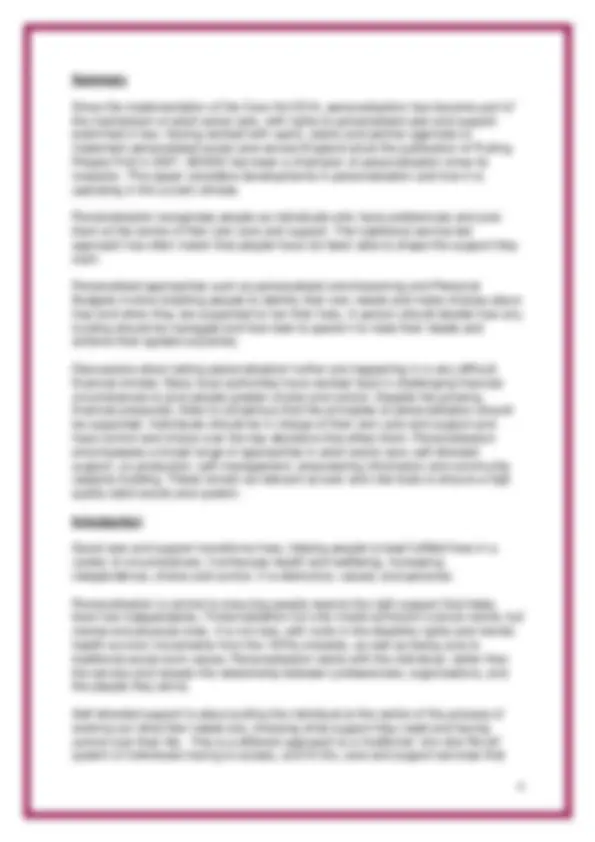
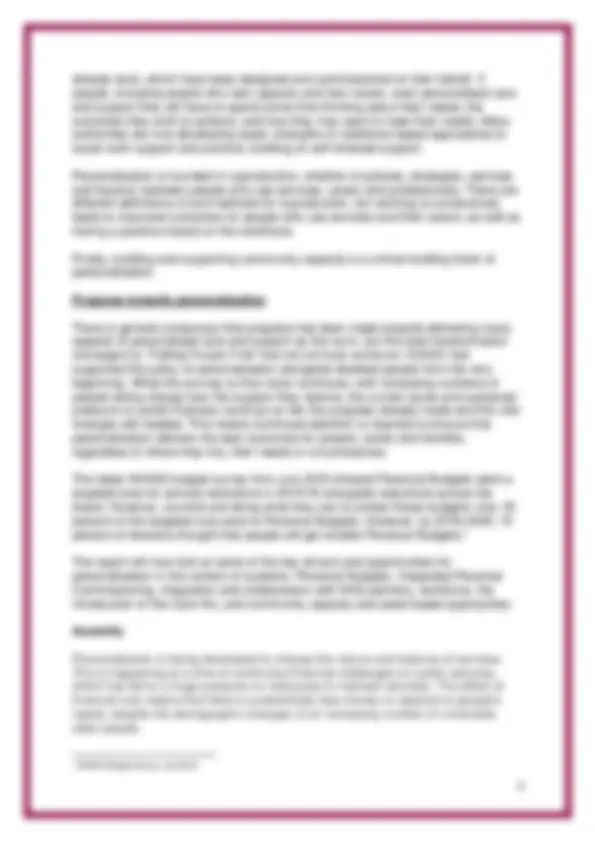
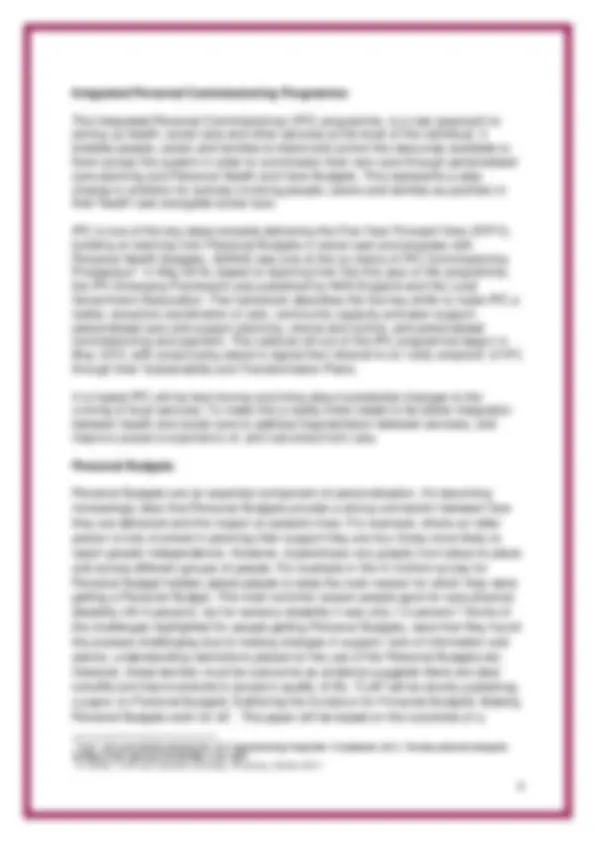
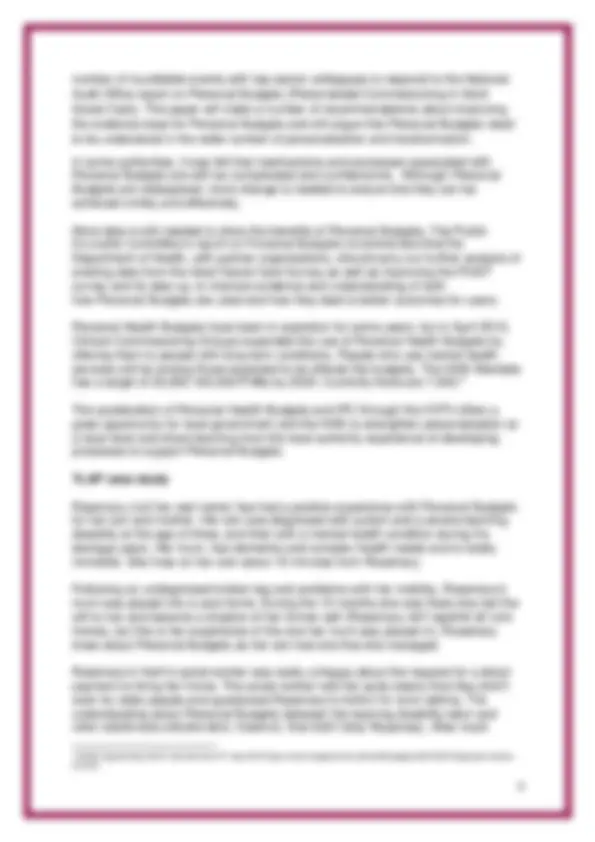



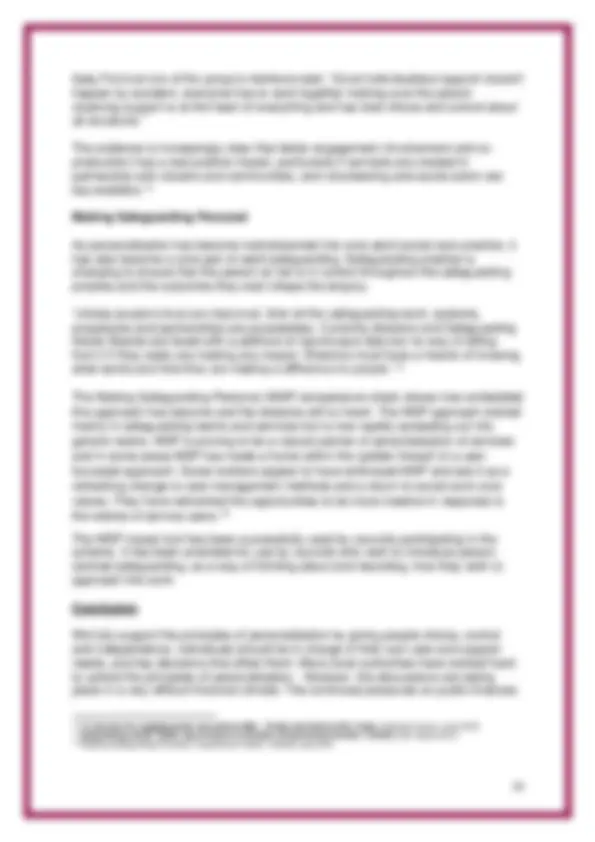


Study with the several resources on Docsity

Earn points by helping other students or get them with a premium plan


Prepare for your exams
Study with the several resources on Docsity

Earn points to download
Earn points by helping other students or get them with a premium plan
Community
Ask the community for help and clear up your study doubts
Discover the best universities in your country according to Docsity users
Free resources
Download our free guides on studying techniques, anxiety management strategies, and thesis advice from Docsity tutors
The implementation and impact of personalisation in adult social care since the Care Act 2014. It highlights the benefits of personalised care and support, the progress made towards its implementation, and the challenges faced in achieving full personalisation. The document also explores key drivers and opportunities for personalisation, including Personal Budgets, Integrated Personal Commissioning, and community capacity building.
What you will learn
Typology: Study notes
1 / 17

This page cannot be seen from the preview
Don't miss anything!










Contents
Page
Summary 3
Introduction 3
Progress towards Personalisation 4
Austerity 4 Strength based work 5 o Shropshire County Council o London Borough of Barnet Integrated Personal Commissioning Programme 7 Personal Budgets 7 o North East Lincolnshire FOCUS o TLAP case study Integration and collaboration with NHS partners 10 Workforce 11 Care Act 11 Community capacity and asset based approaches 12 o Derby City Council Co-production 13 Making Safeguarding Personal 14
Conclusion 14
Appendices
Appendix 1 16
Supporting documents
Summary
Since the implementation of the Care Act 2014, personalisation has become part of the mainstream of adult social care, with rights to personalised care and support enshrined in law. Having worked with users, carers and partner agencies to implement personalised social care across England since the publication of Putting People First in 2007, ADASS has been a champion of personalisation since its inception. This paper considers developments in personalisation and how it is operating in the current climate.
Personalisation recognises people as individuals who have preferences and puts them at the centre of their own care and support. The traditional service-led approach has often meant that people have not been able to shape the support they want.
Personalised approaches such as personalised commissioning and Personal Budgets involve enabling people to identify their own needs and make choices about how and when they are supported to live their lives. A person should decide how any funding should be managed and how best to spend it to meet their needs and achieve their agreed outcomes.
Discussions about taking personalisation further are happening in a very difficult financial climate. Many local authorities have worked hard in challenging financial circumstances to give people greater choice and control. Despite the growing financial pressures, there is consensus that the principles of personalisation should be supported. Individuals should be in charge of their own care and support and have control and choice over the key decisions that affect them. Personalisation encompasses a broad range of approaches in adult social care: self-directed support, co-production, self-management, empowering information and community capacity building. These remain as relevant as ever and vital tools to ensure a high quality adult social care system.
Introduction
Good care and support transforms lives, helping people to lead fulfilled lives in a variety of circumstances. It enhances health and wellbeing, increasing independence, choice and control. It is distinctive, valued, and personal.
Personalisation is central to ensuring people receive the right support that helps them live independently. Personalisation not only meets someone’s social needs, but mental and physical ones. It is not new, with roots in the disability rights and mental health survivor movements from the 1970s onwards, as well as being core to traditional social work values. Personalisation starts with the individual, rather than the service and recasts the relationship between professionals, organisations, and the people they serve.
Self-directed support is about putting the individual at the centre of the process of working out what their needs are, choosing what support they need and having control over their life. This is a different approach to a traditional ‘one size fits all’ system of individuals having to access, and fit into, care and support services that
already exist, which have been designed and commissioned on their behalf. If people, including people who lack capacity and their carers, want personalised care and support they will have to spend some time thinking about their needs, the outcomes they wish to achieve, and how they may want to meet their needs. Many authorities are now developing asset, strengths or resilience based approaches to social work support and practice, building on self-directed support.
Personalisation is founded in coproduction, whether of policies, strategies, services and beyond, between people who use services, carers and professionals. There are different definitions of and methods for coproduction, but working co-productively leads to improved outcomes for people who use services and their carers, as well as having a positive impact on the workforce.
Finally, building and supporting community capacity is a critical building block of personalisation.
Progress towards personalisation
There is general consensus that progress has been made towards delivering many aspects of personalised care and support as the norm, but the total transformation envisaged by ‘Putting People First’ has not yet been achieved. ADASS has supported the policy of personalisation alongside disabled people from the very beginning. While the journey to that vision continues, with increasing numbers of people taking charge over the support they receive, the current acute and sustained pressure on public finances could put at risk the progress already made and the vital changes still needed. This means continued attention is required to ensure that personalisation delivers the best outcomes for people, carers and families, regardless of where they live, their needs or circumstances.
The latest ADASS budget survey from July 2016 showed Personal Budgets were a targeted area for service reductions in 2015/16 alongside reductions across the board. However, councils are doing what they can to protect these budgets: only 18 percent of the targeted cuts were to Personal Budgets, However, by 2018-2020, 72 percent of directors thought that people will get smaller Personal Budgets.^1
The report will now look at some of the key drivers and opportunities for personalisation in the context of austerity: Personal Budgets, Integrated Personal Commissioning, integration and collaboration with NHS partners, workforce, the introduction of the Care Act, and community capacity and asset based approaches.
Austerity
Personalisation is being developed to change the nature and balance of services. This is happening at a time of continuing financial challenges on public services, which has led to a huge pressure on resources to maintain services. The effect of financial cuts means that there is substantially less money to respond to people's needs, despite the demographic changes of an increasing number of vulnerable older people.
(^1) ADASS Budget Survey, July 2016
different ways to take a Personal Budget so the individual can make an informed choice. A fact sheet on ISFs helps with the discussion, regardless of whether the individual chooses a council managed service or an ISF.
Shropshire have developed the following to support ISFs: an accreditation process for ISF providers, which involves a visit from contracting and checks on key requirements (recruitment, safeguarding and contingency etc.) auditing of ISFs to ensure providers are using the ISF flexibly and in line with support plan outcomes a move away from ISF paper agreements to electronic agreement which helps speed up processes introduced the ability to bank hours for extra flexibility require ISF providers to produce monthly statements to the service user
London Borough of Barnet
London Borough of Barnet is implementing strengths based approaches into assessments and support planning, and wider social work practice. It is framed with clear principles, and practitioners and users are actively influencing the shape of the programme and the rollout. All staff are being supported and trained so that social care assessments and support plan focus on the strengths of the service user. There is a focus on practitioners understanding what’s available in their community that could contribute to good support.
An example of one of these projects is a local knitting group ‘Wire We Knitting’ run in Totteridge. The group is run by a local lady who runs a knitted wire jewelry business in Barnet. She works from home and attends regular outside retail events throughout the year. However, following a period of illness, her outside events had to be cancelled and she began to feel quite isolated, convalescing and running her business purely online.
She was a regular customer of The Waiting Room café and knew the owners. She wanted to feel less isolated and missed the usual social interaction the retail events provided, she also wanted to give something back to the community. So the Waiting Room became the meeting space. Over the next year the group grew through social media and the development of a website, meetup, which helps people with similar interests to connect. Their search engine allows anyone with particular interests, to see what is available within five miles of where they live. Within two weeks of being an official meetup group, she had over 75 members join.
People who attend get so much more out of a shared activity. Most members live locally, exchanging invaluable information about local issues and services, and the group is a great support network.
This is of great social value. Really natural community development and the community supporting itself to be resilient. With no state aid!^2
(^2) http://www.thinklocalactpersonal.org.uk/Blog/author/Martin-Walker/
Integrated Personal Commissioning Programme
The Integrated Personal Commissioning (IPC) programme, is a new approach to joining up health, social care and other services at the level of the individual. It enables people, carers and families to blend and control the resources available to them across the system in order to commission their own care through personalised care planning and Personal Health and Care Budgets. This represents a step change in ambition for actively involving people, carers and families as partners in their health care alongside social care.
IPC is one of the key steps towards delivering the Five Year Forward View (5YFV), building on learning from Personal Budgets in social care and progress with Personal Health Budgets. ADASS was one of the co-chairs of IPC Commissioning Prospectus^3. In May 2016, based on learning from the first year of the programme, the IPC Emerging Framework was published by NHS England and the Local Government Association. The framework describes the five key shifts to make IPC a reality: proactive coordination of care, community capacity and peer support, personalised care and support planning, choice and control, and personalised commissioning and payment. The national roll-out of the IPC programme begun in May 2016, with areas being asked to signal their interest to be ‘early adopters’ of IPC through their Sustainability and Transformation Plans.
It is hoped IPC will be fast moving and bring about substantial changes to the running of local services. To make this a reality there needs to be better integration between health and social care to address fragmentation between services, and improve people’s experience of, and outcomes from care.
Personal Budgets
Personal Budgets are an essential component of personalisation. It's becoming increasingly clear that Personal Budgets provide a strong connection between how they are delivered and the impact on people's lives. For example, where an older person is fully involved in planning their support they are four times more likely to report greater independence. However, experiences vary greatly from place-to-place and across different groups of people. For example in the In Control survey for Personal Budget holders asked people to state the main reason for which they were getting a Personal Budget. The most common reason people gave for was physical disability (40.3 percent), but for sensory disability it was only 1.2 percent.^4 Some of the challenges highlighted for people getting Personal Budgets, were that they found the process challenging due to making changes in support, lack of information and advice, understanding restrictions placed on the use of the Personal Budgets etc. However, these barriers must be overcome as evidence suggests there are clear benefits and improvements to people’s quality of life. TLAP will be shortly publishing a paper on Personal Budgets ‘Gathering the Evidence for Personal Budgets: Making Personal Budgets work for all’. The paper will be based on the outcomes of a
(^3) TLAP, LGA and ADASS produced the ‘IPC Commissioning Prospectus’ in September 2014. This was published alongside ‘Getting serious about personalisation in the NHS’. 4 In Control, TLAP and Lancaster University, PB survey, October 2014.
fighting and firmness her mum was offered a direct payment. They organised her support staff, got the house ready and brought her home.
By choosing and employing their own staff Rosemary is able to keep consistency and reliability in both her son’s and her mother’s life. They have had the same personal assistants (PA) for her son for the last 11 years and can plan things successfully around his scheduled support. It is a lot less stressful as Rosemary knows her son and her mum are getting good quality person centred care. Rosemary’s mother has been successfully using a direct payment for the last five years, she loves the people who support her and they love her.
For her son it has meant that he can take part in his hobby. He has a real passion for World War Two and is a fanatical World War Two re-enactor and member of several living history groups. Rosemary used to take her son every weekend, but he knew it wasn’t really her thing. Now his Personal Budget helps go towards a PA to take him to these re-enactments. They are often over-night so while her son pays for all his own costs, the Personal Budget goes towards the expenses that his personal assistant will have, such as hotel bills. Before he started re-enacting he didn't have a particular focus in life, however, since going to re-enactments his interest has encouraged him in so many ways. For example, it has given him the desire to learn to read and write and spurred him on academically.
Personal Budgets have had a really positive impact on all of Rosemary’s family’s lives, Rosemary has gone back to being a daughter to her mum and a mum to her son.^6
North East Lincolnshire FOCUS
Agnes (not her real name) is in her 80s with dementia, she lives in her own home alone and has no local family network. She needs help with personal care, diet, medication, finances, shopping and housework. Most of all, Agnes wanted to remain in her own home.
However, Agnes was not coping very well. The support provided during this period consisted of: four - 30 minute calls per day for personal care, one shopping and one cleaning call per week, and corporate appointee for finances.
It was decided that the support package was not working, that the risks were too great, and Agnes was placed in respite care. Analysing a number of cases where people had been admitted to respite care with similar and lesser needs, the general result was that they became permanent residents with poor outcomes, in terms of their health, and increased dependency levels.
In Agnes’ case there was a determined effort to return her home, which led to: Agnes being allocated a Personal Budget work by the financial appointee to enable her to use some of her own money to part fund a new care package, Agnes supported to appoint her own team of 3 carers
(^6) TLAP case study, provided April 2016.
extended support hours from 8am to 1pm and from 3pm to 8pm just checking service tele-care to monitor ‘gaps’
Due to the more intensive involvement by a consistent staff team it was quickly realised that Agnes’ night wandering was related to severe weather conditions, it was therefore agreed that the carers could put in an extra night shift, without the involvement of the case manager, in these circumstances. These are purchased by Agnes but monitored by the appointee.
The outcome for Agnes was extremely positive: Care staff got on well with Agnes and made sure they put her needs and wishes first They supported Agnes to go shopping, to cook and bake making sure she had fresh cooked food every day Agnes used to be a keen golfer and was able to take part in sessions on the driving range, which was something she hadn’t been able to do in a long time Agnes now enjoys gardening with her carers The carers have helped her establish contact with family members who had moved to New Zealand Agnes has a bus pass and goes out for meals and shopping trips with her carers, which is an enormous change from the isolated life she was leading that was greatly impacting on her mental and physical health.^7
Integration and collaboration with NHS partners
The aim of integration is to help organisations work across traditional boundaries to better deliver co-ordinated care and support that improves people’s health and wellbeing. Integrated care is primarily about an individuals’ experience of care and ensuring better outcomes through coordinated, person-centred care and support.
Real integration of health and care services holds the promise of accelerating the delivery of personalisation, through providing seamless care, tailored to the individual’s needs and focused on outcomes rather than the workforce, organisational structures or the setting in which care is delivered. It should allow patients to choose and control what care they receive, where and by whom it is provided by and place more emphasis on prevention. Some areas have been further hampered by a lack of commitment to make the necessary changes to clinical practices and operational processes. This has limited transformation and reduced the scope and scale of benefits.
It is important that the commissioning landscape that underpins the health and social care system in 2020 is characterised as much by the ability to personalise and shape care and support in response to individual needs and preferences, as it is by place- based approaches and new models of care.
(^7) North East Lincolnshire FOCUS, September 2016
as possible, preventing the development of ill health and social care needs, and focusing on the needs of the individual rather than the demands of the service, but our budget surveys show that increasingly only those with the highest levels of need are able to access state funded services and increasingly expenditure on prevention is being squeezed.
In Control carried out a survey that asked how much difference the Care Act 2014 had made to the experience of people with care and support needs, and carers. A third of respondents said they had less choice and control over the support they received. Half reported that councils were restricting the use of how their budgets were spent regarding personal care – meaning help with such things as washing and dressing, rather than help to leave the house.^11 TLAP will soon be publishing the results of a survey of the Care Act. The survey has focused exclusively on people who use services and carers.
Community capacity and asset based approaches
The ability to feel part of and contribute to a community is a right everyone should have. Everyone has something to offer. We know that profound changes can happen when ordinary people take the initiative. People need to feel they can not only be in the community, but part of the community as well.
Assets, strengths or resilience-based approaches help people and communities to come together to achieve positive change using their own experience, knowledge and skills. These approaches recognise the personal, social and physical capital that exists within local communities.
However, these approaches should not be seen as just a free substitute for care – they can provide care and support but offer more. Communities and families need also to be supported with strength based working to avoid exploiting caring individuals.
Derby City Council
Derby City Council has developed a Local Area Coordination Scheme which aims to involve local people in developing local services. Derby’s scheme has three main aims: People not yet known to services to help build resilience and remain part of their community (staying strong – avoiding need for services) People at risk of becoming dependent on services to remain strong in their own community diverting the need for more expensive ‘formal service’ responses (reduce demand). People already reliant on services to become less so and more resilient in their own community.
The Local Area Coordination Scheme specifically meets the Care Act duty to prevent, reduce or delay the need for care.
(^11) In Control, Independent Living Survey, November 2016.
In March 2016, a social evaluation was carried out on Derby City Council’s Local Area Coordination Scheme. It found the following conclusions: People less reliant on traditional services - find community based solutions to their problems People had improved health and wellbeing – reduced loneliness and social isolation, increased confidence, independence and control over their lives Supports Care Act duties to empower people and improve health and wellbeing outcomes through community solutions. Supports the 5YFV’s focus on prevention, person centred and flexible care through local and joined up support Demonstrates the value and cost benefit to support continued investment through the Better Care Fund and Adult Social Care Funding and potential value should the service be expanded to all 17 wards. Generates £4.00 of social value for every £1.00 invested
One of Derby’s successful schemes is in Alvaston. They have identified community ‘citizens’, leaders to help develop local resources for example, the Alvaston Residents’ Association. They have undertaken a number of local actions: community funding events; developing a local resource database, ‘Alvaston Community Exchange’, set up a carers group and developed a number of community coordinators.^12
Co-production
Think Local Act Personal’s (TLAP) National co-production advisory group is a key forum to help support personalised services. They are committed to making sure that personalised services and support based in the community become a reality for everyone. ADASS works closely with the co-production advisory group and TLAP more widely, to raise the profile of the personalisation agenda.
(^12) SROI evaluation TLAP commissioned for the Derby LAC scheme
could put at risk the progress made with personalisation and the important changes still needed. There needs to be continued attention to the personalisation agenda to ensure that it delivers the best outcomes for people, carers and families, regardless of where they live, their needs or circumstances. The principles of personalisation remain as relevant as ever and vital to ensure a high quality adult social care.
Although adult social care is well on the way in this journey, there is more to do to realise the full vision of personalisation. The examples in this paper show some of the ways of working that can help bring about that further development and show the potential of personalisation in a climate of austerity.
Appendices
Appendix 1
Sponsors – Dawn Wakeling and Denise Porter Personalisation Network members Staff – Mark Hill, Andriana Delevich
During the course of the work we have engaged with a number of organisations: The Personalisation Network National Conference of Adult Services The Eastern and West Midlands ADASS regions College of Occupational Therapists Think Local Act Personal (TLAP) and NCAG Integrated Personal Commissioning Programme
Supporting documents Distinctive Valued Personal , ADASS, March 2015 Budget survey , ADASS, June 2015 Putting People First , DH, December 2009 Five Year Forward View , NHSE, October 2014 Vision 2020 , In Control, 2010 Integrated Personal Commissioning, Emerging Framewor k, NHSE, May 2016 Making It Real , TLAP, October 2011 Personalisation Action Plan, TLAP, May 2014 Making Safeguarding Personal Evaluation, October 2015